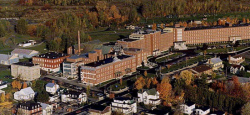Difference between revisions of "St. Julien Asylum"
(Created page with "{{infobox institution | name = St. Julien Asylum | image = QCstjulien1.png | image_size = 250px | alt = | established = 1870 | construction_began = | opened = 1917 (Second Buil...") |
m |
||
| Line 21: | Line 21: | ||
==History== | ==History== | ||
| − | In 1872, six nuns from the Sisters of Charity of Quebec | + | In 1872, six nuns from the Sisters of Charity of Quebec arrived in the hamlet of St. Ferdinand at the invitation of the local cure, Julien Bernier. They founded a hospice and girls' school, and within a year, 20 patients with intellectual disabilities -then considered an illness -were on their way from the overcrowded provincial asylum in Beauport. |
The original building burned in 1916, killing 45 inmates & 1 of the sisters. The one-kilometre-long St. Julien Hospital re-opened after the terrible fire and had about 500 patients until it closed in 2003. By the 1940s, nearly 1,000 patients filled St. Julien's 84-bed dormitories, each overseen by one or two nuns. In its heyday from 1940-1970, as many as 1,500 mental patients lived in the red brick asylum that stretches the length of three football fields along the main street. | The original building burned in 1916, killing 45 inmates & 1 of the sisters. The one-kilometre-long St. Julien Hospital re-opened after the terrible fire and had about 500 patients until it closed in 2003. By the 1940s, nearly 1,000 patients filled St. Julien's 84-bed dormitories, each overseen by one or two nuns. In its heyday from 1940-1970, as many as 1,500 mental patients lived in the red brick asylum that stretches the length of three football fields along the main street. | ||
| Line 31: | Line 31: | ||
A 1984 wildcat strike by 717 orderlies caused bitter tensions and a successful class-action suit against the strikers on behalf of patients. The re-drawing of administrative regions in 1993 amputated most of the territory the hospital had formerly served. Patients were transferred to foster homes and other facilities in Thetford Mines and Victoriaville, and the hospital emptied. | A 1984 wildcat strike by 717 orderlies caused bitter tensions and a successful class-action suit against the strikers on behalf of patients. The re-drawing of administrative regions in 1993 amputated most of the territory the hospital had formerly served. Patients were transferred to foster homes and other facilities in Thetford Mines and Victoriaville, and the hospital emptied. | ||
| − | Filmmaker Serge Gagne | + | Filmmaker Serge Gagne was among a group of St. Ferdinand residents who submitted a bid to acquire the former hospital in 2008. The Cooperative de developpement local de St. Ferdinand (COSODE-LO) proposed to convert the property for housing, cultural activities, a rural research centre and greenhouses. The CHQ rejected the proposal from because the project would have required government subsidies.<ref>[http://www.nytimes.com/1993/05/21/world/orphans-of-the-1950-s-telling-of-abuse-sue-quebec.html?pagewanted=all&src=pm]</ref> |
==Images== | ==Images== | ||
Latest revision as of 23:58, 2 September 2014
| St. Julien Asylum | |
|---|---|
 | |
| Established | 1870 |
| Opened | 1917 (Second Building) |
| Closed | 2003 |
| Demolished | 2012 |
| Current Status | Demolished |
| Building Style | Single Building |
| Location | Saint-Ferdinand, QC |
| Alternate Names |
|
History[edit]
In 1872, six nuns from the Sisters of Charity of Quebec arrived in the hamlet of St. Ferdinand at the invitation of the local cure, Julien Bernier. They founded a hospice and girls' school, and within a year, 20 patients with intellectual disabilities -then considered an illness -were on their way from the overcrowded provincial asylum in Beauport.
The original building burned in 1916, killing 45 inmates & 1 of the sisters. The one-kilometre-long St. Julien Hospital re-opened after the terrible fire and had about 500 patients until it closed in 2003. By the 1940s, nearly 1,000 patients filled St. Julien's 84-bed dormitories, each overseen by one or two nuns. In its heyday from 1940-1970, as many as 1,500 mental patients lived in the red brick asylum that stretches the length of three football fields along the main street.
The hospital became infamous for allegations of abuse in 1990 that occurred during the 1940's and and early 60's. Normal children but orphans were falsely labeled as mentally retarded by corrupt doctors and put in Quebec's most important psychiatric institutions, which included the Saint-Julien hospital, were they suffered terrible treatments.
In his 2002 memoir Docteur et citoyen (Boreale), late Quebec cabinet minister Denis Lazure, who died in 2008, recalled his days as a young psychiatrist in Quebec asylums where generous use of tranquillizers, straitjackets, isolation cells and electroshock without medication were routine. Doctors injected patients with insulin to induce diabetic comas, from which some never awoke, Lazure wrote. During the Quiet Revolution in the 1960s, lay staff replaced nuns in key positions and employment boomed.
A 1984 wildcat strike by 717 orderlies caused bitter tensions and a successful class-action suit against the strikers on behalf of patients. The re-drawing of administrative regions in 1993 amputated most of the territory the hospital had formerly served. Patients were transferred to foster homes and other facilities in Thetford Mines and Victoriaville, and the hospital emptied.
Filmmaker Serge Gagne was among a group of St. Ferdinand residents who submitted a bid to acquire the former hospital in 2008. The Cooperative de developpement local de St. Ferdinand (COSODE-LO) proposed to convert the property for housing, cultural activities, a rural research centre and greenhouses. The CHQ rejected the proposal from because the project would have required government subsidies.[1]